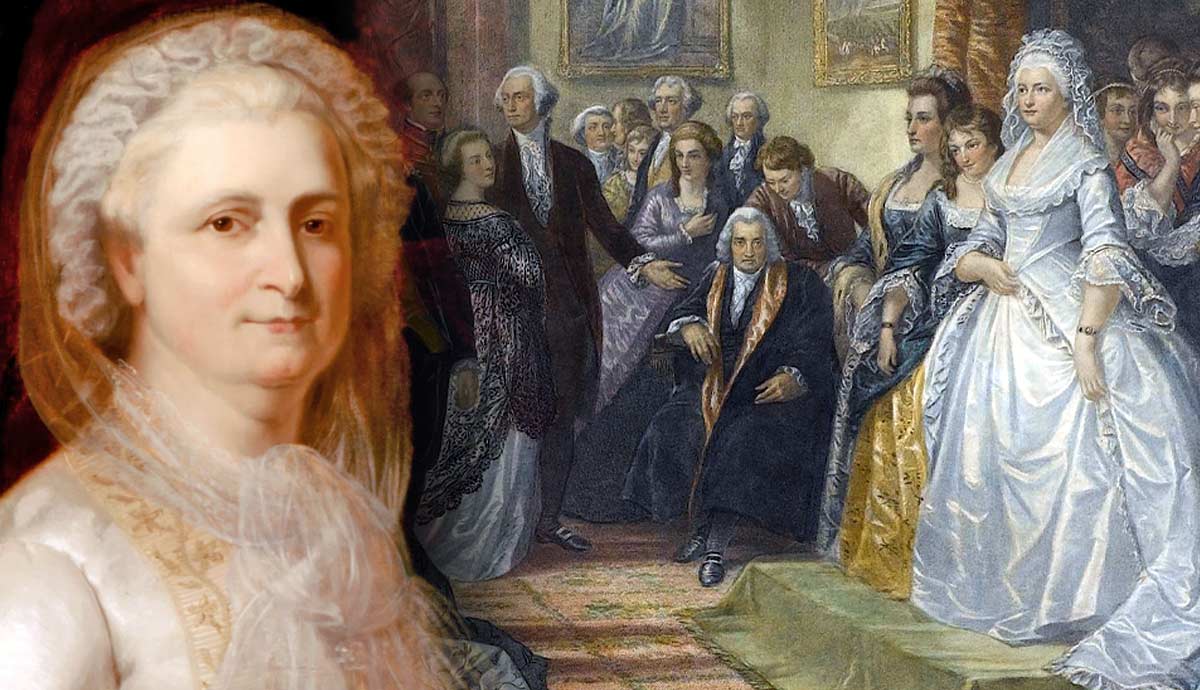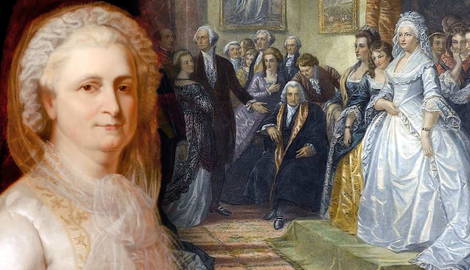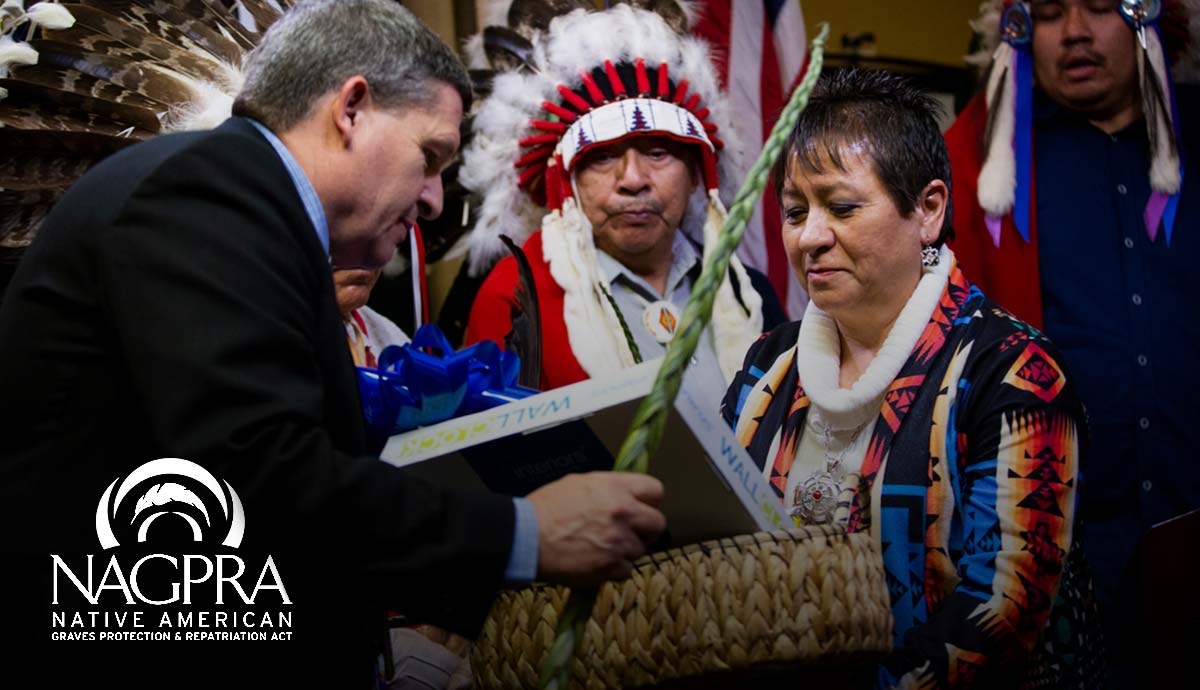
The original First Lady of the United States created an example for those who came after to follow. Martha Washington was famous for her unwavering dedication to her husband, George Washington, both publicly and privately, as he worked to develop and mold the country that America became, but there was so much more to her than that. At times a victim of tragic circumstances, Martha’s determination ensured her future success. Her efforts not only supported her husband but paved the way for the new government to define itself.
Young Martha

Like her future husband, Martha was a native Virginian. Martha Dandridge entered the world on June 2, 1731 in New Kent County. She was the eldest of John and Frances Dandridge’s eight children who lived at Chestnut Grove Plantation. Expected to grow up to be the wife of a planter, like her mother before her, Martha was schooled in the skills required to run a household and social etiquette from a young age.
However, she also learned to read and write and had a lifelong interest in literature, from scripture to novels. As she grew into her teens, Martha began a courtship with a local planter’s son, Daniel Parke Custis. Custis’ family opposed the relationship, as they had a higher level of wealth than the Dandridges. After meeting Martha, Custis’ father relented to the romance, saying he was “enamored” with Martha and her character. Daniel and Martha wed in 1750. The two had four children over the next six years, two of whom died in early childhood.
Changes & Success

Martha was suddenly widowed in 1757 after only seven years of marriage. Custis died suddenly, with the cause seeming to stem from a severe infection in his throat. He was laid to rest in Williamsburg, alongside his two children who had predeceased him, under an elaborate tombstone that Martha shipped from England.
At a time when very few women owned property, Martha suddenly became the wealthiest woman in the Virginia Colony. She was now in charge of the over 15,000-acre Custis estate, which included 300 enslaved persons as its labor force. In addition, she had her two small children, John, known as Jacky, and Martha, called Patsy, to care for.
Despite the challenges she suddenly faced, Martha soon proved to be skilled at plantation management. She continued Custis’ thriving tobacco exportation business, maintaining contacts in England to represent her legal and business interests abroad. She demanded the best in equipment and supplies from her vendors and didn’t hesitate to tackle matters of the law that arose. With the large cash reserves in the estate, Martha offered loans to other local planters, earning high interest as a return on her investments.

Less than one year after her husband’s passing, suitors began approaching Martha. The 27-year-old received several young men, but one in particular caught her eye: a young militia officer named George Washington.
The two wed in 1759, and Martha left the Custis plantation to take on her new role as the mistress of Washington’s family estate, Mount Vernon. She retained one-third of the Custis estate as a future inheritance for her children and brought several enslaved people from her former home to her new one.
Martha stepped into position at Mount Vernon, becoming a valuable asset to Washington with her plantation management experience. Though her husband Washington held legal rights over his wife and her property, he involved her in legal consultations, and she made many commercial decisions relating to the estate and its production. George became the legal guardian of Jacky and Patsy, and the couple often opened their home to nieces and nephews. They never had biological children of their own. They’d later assume care of Jacky’s children when he died of “camp fever,” now known as epidemic typhus, during the American Revolution.
War Arrives

In 1775, the Revolutionary War began, forever changing the life of the Washingtons. George became the Commander in Chief of the hopeful nation’s army, which would require his extended absence from his beloved Mount Vernon. Now General Washington had become famous for his adventures in the French and Indian War and was an easy choice among the members of the Continental Congress to lead the new army.
Washington’s absence and his new responsibilities, along with the outbreak of battle, put a strain on the couple’s marriage, but Martha did not waver as new challenges arose. She and her husband became public figures that people were looking to for leadership and hope. Martha entertained a variety of people, from military figures to society women, both at Mount Vernon and at army outposts throughout the war.
She joined her husband at “winter camps” as fighting ceased for the season. In order to stay at these locations for extended periods, it was suggested that Martha partake in smallpox variolation. A precursor to vaccination, variolation exposed a patient to material from smallpox pustules. This usually resulted in mild infection and strong immunity to smallpox, which ravaged the ranks and the country as a whole during the Revolution. In fact, in 1777, Washington made variolation mandatory for his forces. While the thought of variolation and the potential risks terrified Martha, she underwent the procedure in order to be with her husband and spent many months with him during the war.
She traveled often dangerous routes to spend time at camps in Valley Forge, Philadelphia, and Cambridge, among others. On these trips, she provided secretarial duties to her husband and often served as a sounding board, just as she had when the couple were home.

A believer in the cause behind the Revolution, Martha supported all soldiers, not just her husband. In 1780, she became the public face of a colonies-wide drive to raise money for army supplies that were desperately lacking. While in the camps, she cared for ailing men and organized social events with other officers’ wives to improve morale.
These would be far from Martha’s last trips away from Mount Vernon. As her husband ascended to the first presidency of the United States, he found himself in a precarious position—what he did would shape the role of the presidential office for years to come. Martha was in an equally demanding position, as she would define the role of First Lady.
All eyes were on her as she not only supported her husband but created her own legacy. The first couple lived first in New York, then in Philadelphia. Martha became famous for her Friday evening receptions during the presidency, in which she hosted everyone from foreign dignitaries to great thinkers, inviting both men and women to participate in these informal socio-political events.
Wishes for Retirement

The Washingtons were overjoyed when the time came to leave the presidency and return to their beloved home. Eager to focus on one another and enjoy their golden years, the pair returned to Virginia for good in 1797. Now considered figures of international importance, they hosted many guests and enjoyed time with their grandchildren and great-grandchildren.
Their twilight years together were short-lived, however, as Washington died just two years after their arrival home. His cause of death was likely bacterial epiglottis, a type of throat infection. He was also bled extensively, both at his request and at his doctor’s decree. Though it is estimated that Washington lost over 40% of his blood as a result, it is not believed that for a man of his size, this would have contributed to his death.
Regardless of the cause, Martha was despondent over the loss of her husband. She closed off their bedroom and moved to another part of the house, spending most of her days in her room. Wearing mourning black in public, Martha was often adorned with a locket or ring containing a lock of her husband’s hair. She later burned their correspondence to protect the sanctity of their relationship, a common practice for the time. Martha joined her husband in death less than three years later and was buried alongside him.
Outliving two husbands and all four of her children, at age 70, she succumbed to a “severe fever.” She was eulogized as “the worthy partner of the worthiest of men” in newspapers throughout the United States.
Another Legacy: Martha the Slaveholder

It would be impossible to tell Martha’s story without considering the impact of slavery. Martha grew up in a world where slavery was a norm and a necessity to the plantation system as it stood. She was part of slave-owning households for her entire life and oversaw the welfare of hundreds of slaves as she became the head of her husband’s estate.
Martha never publicly stated opinions on slavery and never seemed to have questioned its existence like her husband, George Washington, did. She seemed to accept human bondage as a fact of life, giving enslaved people as “gifts” and utilizing their labor to complete what she called “drudgery duties” of the home until her death. Though George Washington would free all of his enslaved people upon his death, Martha did not follow his example when her own end arrived.

Imperfect yet iconic, Martha Washington played a role in creating the foundation of America’s development as a singular entity unique from Britain. Her actions as not just Washington’s supporter but also a partner developed a role that future first ladies could grow and achieve. While her husband will remain one of the United States’ foundational emblems, in all likelihood, he would not have been nearly as impactful without Martha by his side.










